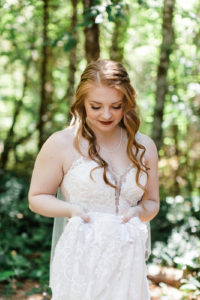
How to Honor a Deceased Loved One at Your Wedding
Your wedding day is one of the most important days of your life and although nothing could replace your loved one being present, we’ve brainstormed a few ways you can honor them on your day.
If you’ve made the awesome decision to say your vows in the great outdoors, there’s nothing worse than leaving behind the rings (actually happened to us on our wedding day!) or even worse, something critical to your survival. When you are trying to coordinate for you big day and have a million things going through your head, it can be easy to forget something essential. We’ve created this guide and checklist to help prepare couples for their ultimate adventure wedding! This guide will make sure you’re ready to get hitched with mother nature as your witness. We’ll break things down into the absolute essentials and then propose a few other rugged comforts to make your trip unforgettable.
Our list is intentionally long. It includes items we recommend considering for trips in any weather condition. While some of the gear might seem excessive or unnecessary, the exact items that you decide to bring with you for should be tailored to the type of trip and other factors including:
Your level of experience and your acceptance of risk
How isolated the trail may be or the distance from getting help
Round-trip trail distance, difficulty, and duration
Time of day and weather
We’ve also created a google spreadsheet for you to update for your own use. It includes some examples and our recommendations for some of our favorite gear! Access the template spreadsheet and create a copy. Then you can modify, add or remove items as you see fit.

If you’re feeling particularly motivated, there’s a column for tracking weight for those of you interested in slimming your gear down and getting extra competitive with the lightweight crowd.
Hint: sawing off the handle of your toothbrush or whittling your own utensils from sticks can save a few ounces!
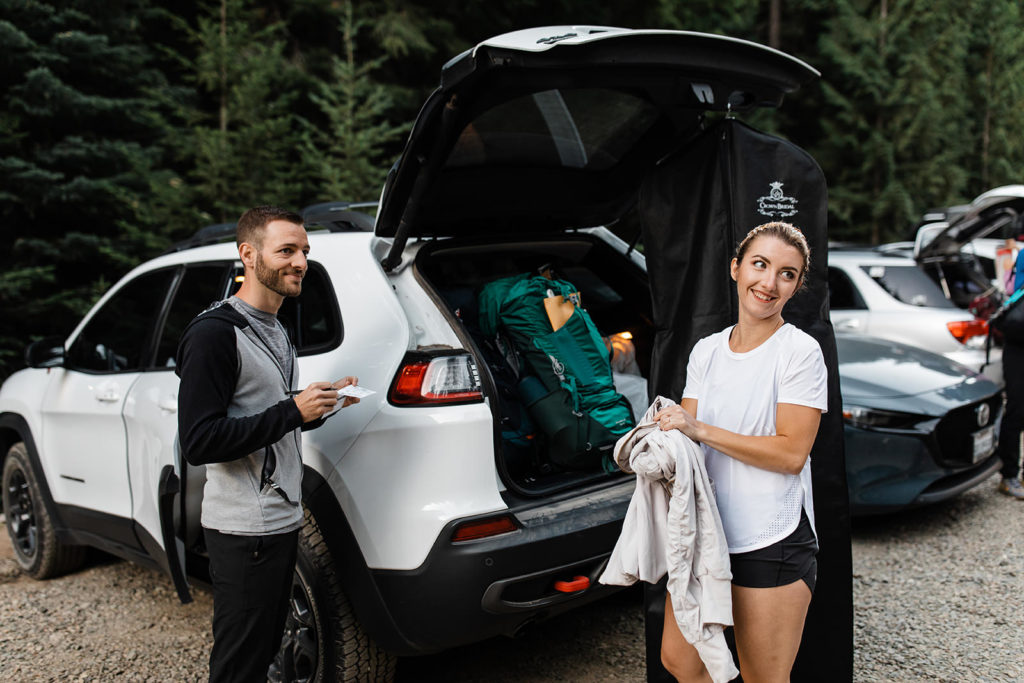
If you’re anything like us, there’s always that feeling of leaving something behind. We tend to group items into groups for easily thinking through a mental check of the broader categories to make sure we have covered at least the essentials. The items with an asterisk, indicate items that are part of the broader 10 essentials program. Check out more details on the ten essentials. Below is a summary of many typical items brought on overnight backpacking elopements.
Dress and/or suit
Dress shoes (optional)
Makeup & hair accessories
Compact mirror
Dry shampoo
Baby wipes
Vows
Rings (or silicone rings)
Ceremony script
Letters from family/friends
Official papers
Cake
Champagne
Something old, new, borrowed, blue
Backpack
Daypack
Pack cover
Shelter (tent, bivy, hammock)*
Stakes & guylines
Rainfly or tarp
Tent footprint
Sleeping bag
Sleeping pad
Pillow
Stove
Fuel
Cook set
Pot grabber
Dish or bowl
Mug or cup
Utensils
Meals*
Snacks*
Extra day’s food*
Water bottle or container*
Water filter/purifier/chemical treatment*
Biodegradable soap
Food protection: bear canister or hang bag & 50+ ft of nylon cord
Navigation
Map (topographic)*
Compass*
Paper protection (maps, guidebook, permit, emergency contacts)
Guidebook or route description
Watch
GPS
Altimeter
Personal locator beacon (avalanche beacon)
Miscellaneous & First Aid
Headlamp (w/ extra batteries)*
Knife or multi-tool*
Fire starter (in waterproof container)*
Whistle and/or mirror
First-aid kit*
Foot care (moleskin & blister treatment)
Repair kit & Duct Tape
Foot traction (microspikes)
Trekking poles
Ice Axe
Sit pad or camp stool
Bear spray
Clothing choices should reflect expectations for weather. Moisture-wicking clothing is essential for base layers and quick-dry material for mid and outer layers are important in both warm and cold weather. Skip items made primarily of cotton. Here are a few quick slogans: “Cotton is rotten” and “if you are cold, put on a hat.”
Base layers (Moisture-wicking)
T-shirts
Long-sleeve shirts
Underwear
Sports Bras
Socks
Mid layers (Quick-drying)
Sun shirts (sun & bugs)
Pants/shorts
Jacket or Light Fleece
Extra clothes (beyond minimum expectation)*
Stuff sacks
Boots or approach shoes
Camp shoes (to give your feet a break from boots)
Sandals (good for stream crossing)
Hat*
Sunglasses & leash*
Face mask (Covid-19)
Optional & Weather Dependent
Warm hat
Bandana or Buff
Gloves
Rain/Snow jacket
Rain/Snow Pants
Insulating jacket or vest
Long underwear
Fleece pants
Gaiters (good for snow or muddy conditions)
Headnet
Hand soap or sanitizer
Wipes
Trowel/blue bags
Toilet paper
Feminine products
Medication
Oral care: toothbrush, toothpaste, floss
Eye care: prescription glasses or contacts
Sunscreen*
Chapstick (w/ SPF)*
Insect repellent
Insect bite care
Itinerary (left with family/friend)
Permits (if necessary)
Parking Pass (if necessary)
Cash or credit cards
Personal Identification
Car keys
Cell phone
Power
Camera
Binoculars
Walkie-talkies
Book
Journal
Star Guide
Bird Guide
Cards or games
Pen & paper
Fishing gear (pole, tackle & license)
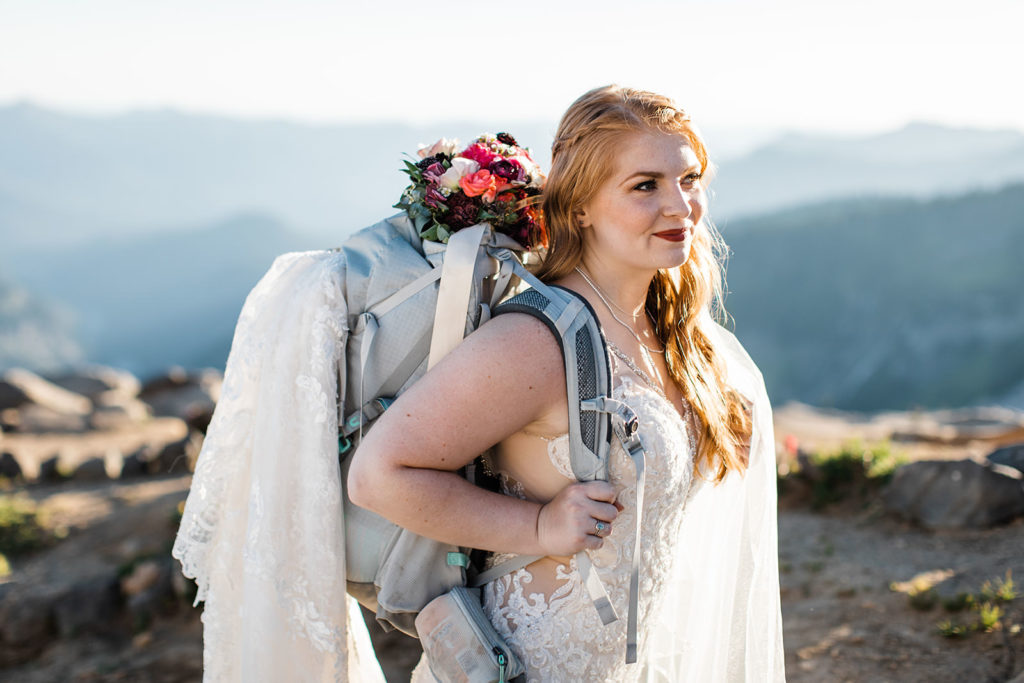
Size of Pack
Many outfitters recommend 30-50 liters is a perfect size for an overnight trip. Honestly, I’d be hard pressed to fit my essential gear in a 30 liter pack for an overnight trip. Even when backpacking without our camera gear, I stuff my 65 liter pack pretty dang full, and I don’t find myself bringing many items beyond what is absolutely necessary (I’m not opposed to sitting on a stump). If you’re packing wedding attire in addition to the necessities for overnight camping, I’d definitely recommend at least a 50 liter pack and potentially a 55-70 liter backpack. Our favorite packs are Osprey packs for their comfort and versatility. There are tons of other features you may want to consider such as frame type, ventilation, pocket design, hydration reservoirs and more. Check out this guide to choosing a pack.

Your wedding day is one of the most important days of your life and although nothing could replace your loved one being present, we’ve brainstormed a few ways you can honor them on your day.
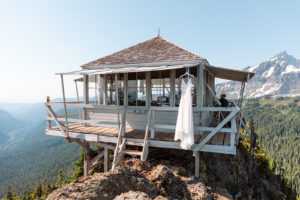
There are lots of things to think about when choosing a space to get ready in before your wedding! From a photographers perspective, these are a few of our suggestions.
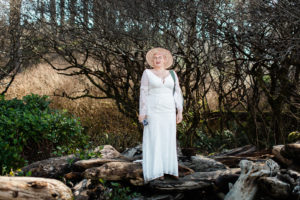
Your wedding dress doesn’t need to be expensive to be perfect! This is our list of places for you to find an affordable wedding dress.